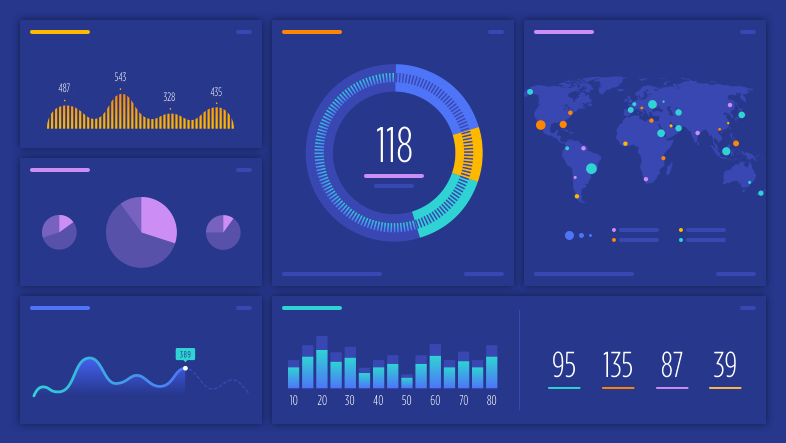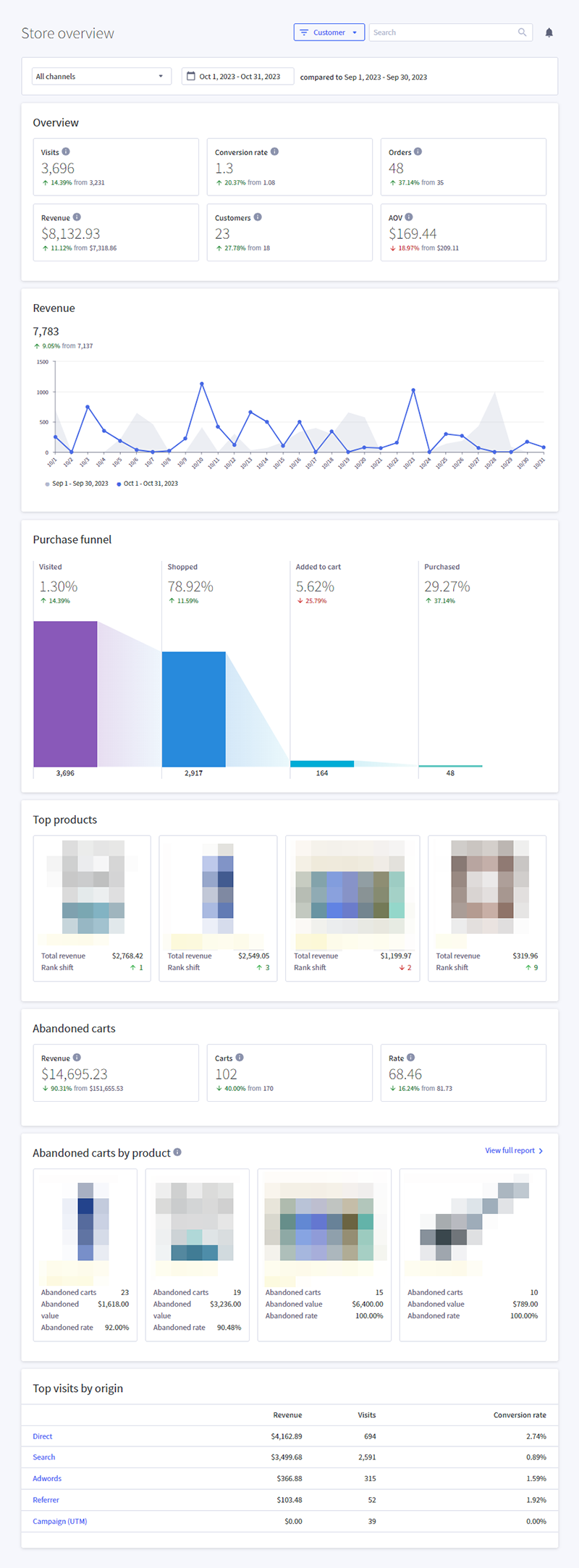
The Store Overview report will provide you a high-level summary of key metrics making it easy to check in on your business. The Store Overview Report can be viewed under Analytics › Overview.

Top Line Statistics
The top line of the dashboard shows all of your store’s key metrics. Each window shows the total value and percentage change for the statistic over the selected date range.
Metric Breakdown
| Metric | Description | Calculation |
|---|---|---|
| Orders | number of orders* (* the order is in an eligible status) | sum of orders |
| Revenue | sum total of money from orders, converted into one currency | sum (revenue from orders in order status) |
| Customers | number of unique individuals who made an order | sum customer IDs with at least one order |
| Visits | total number of visits (this is *not* unique visitors) | sum visits |
| Conversion Rate | percentage of visits that resulted in a complete order | eligible storefront orders / visits |
| AOV | average cart value of each eligible order (not including returns + refunds) | revenue / eligible orders |
Take Action with Data — Monitoring these statistics daily will give you a quick snapshot into what’s happening in your store. Any changes in revenue can be explained first by taking a look at these metrics before going deeper into your statistics.
Understanding how these metrics are interrelated helps you glimpse the causes of any increases or declines in revenue before getting caught up in unnecessary details. In particular, you should ask: Where was the biggest change coming from among visits, conversion rate, and average order value (AOV)? Drilling down on the answer to each question will help explain the driving factors behind any changes in revenue.
Revenue Graph
The Revenue graph charts total revenue over the selected period of time and compares it to revenue from the previous period. To view exact values, hover your mouse over a specific data point. Revenue is displayed in your store’s default currency.
Metric Breakdown
| Metric | Description | Calculation |
|---|---|---|
| Revenue over Time | revenue over a given time period (one day in observed period: hourly)(more than one day in observed period: daily) | sum (revenue from eligible orders) |
Take Action with Data — Viewing these graphs by hour, day, week or month will help you understand what time period is busiest for your site. Track whether new or current marketing campaigns are making a significant impact on revenue and which day of the week and time of the month generates the most sales for your online business.
Purchase Funnel
The purchase funnel measures the actions visitors make on your site before making a purchase.
Metric Breakdown
| Metric | Description | Calculation |
|---|---|---|
| Visited | the total number of visits to your site; visits include each new visit after 30 minutes of inactivity | sum visits |
| Shopped | visits that viewed at least one product page (including quickviews) | sum visits with a product pageview |
| Added to Cart | visits where at least one item was added to cart | sum visits with an add to cart action |
| Purchased | visits with a completed order | sum eligible storefront orders |
| % overall Conversion Rate | percentage of visits that resulted in an order | 100 * (eligible storefront orders / visits) |
| % looked at a product | Shopped / Visits | 100 * (visits with a product pageview / visits with 2 or more pageviews) |
| % put an item in the cart | Added to Cart / Shopped | 100 * (visits with an add to cart action / visits with a product pageview) |
| % completed a sale | Purchased / Added to Cart | 100 * (eligible storefront orders / visits with an add to cart action) |
Take Action with Data — This information allows you to identify at which point you are losing the customer, allowing you to then optimize those particular areas to decrease bounce and increase conversion. For example, are you seeing a large drop-off from the Shopped column to the Added to Cart? Could it be that call to action is lost on the page or below the fold? This is a great tool to see where optimizations can be made with respect to the customer’s journey on the site.
Abandoned Carts
Pro Tip! For more information on abandoned carts and revenue, check out the Abandoned Cart Report and Abandoned Cart Recovery Report.
An abandoned cart happens when a visitor adds an item to the cart but does not attempt to pay (i.e. click Proceed to Payment). (To learn more, see Using the Abandoned Cart Saver). Not to be confused with incomplete orders, which happen when a shopper reached the payment page, but did not complete the transaction.
Metric Breakdown
| Metric | Description | Calculation |
|---|---|---|
| Abandoned Revenue | sum total of the revenue from all abandoned carts in a given time period | sum (revenue -[taxes + shipping]) for abandoned carts |
| Abandoned Carts | sum total of all abandoned carts in a given time period | sum abandoned carts |
| Abandonment Rate | percentage of all carts that were abandoned in a given time period | abandoned carts / carts |
Take Action with Data — This area will show you which products generate the most abandoned carts and the most abandoned revenue. This data is telling you that there are a set of products that for whatever reason, customers are not buying.
If you see the same products show up in the top abandoned products week over week, you can then decide whether you want to promote those products in a different way. You might want to change the product image, or how you describe those products. Also, you may want to create a target campaign to push those products, since you most likely have a lot of inventory on those products.
Top Products
The Top Products window shows the top 5 grossing products. Each product also links to its respective merchandising product report. The number shown in green or red shows how many ranks the product has moved up or down during the comparison period.
Metric Breakdown
| Metric | Description | Calculation |
|---|---|---|
| Product Ranking | products ranked according to revenue over a given time period | sum line item sale price of item for all eligible orders that include it (does not include shipping or tax) - discounts on the product) |
| Product Revenue | sum sale price of a given product, minus discounts over a given time period | sum line item sale price of item for all eligible orders that include it (does not include shipping or tax) - (discounts on the product) |
| Product change in ranking | the change in the products ranking from the observe period to the compare periods | observe product ranking - compare product ranking |
Take Action with Data — Understanding which products are selling well means you can invest more time and money to increase your sales and revenue. The Merchandising Report gives you the opportunity to drill down on products and understand the drivers behind their performance.
By examining poorly performing products, you can experiment with sales, image quality or promotion to test whether any of these variables help improve their performance. Alternatively, you could end up pulling back that product’s budget or eliminating it from your catalog altogether. Naturally, each online business and product will be different.
Top Visits by Origin
Top Visits by Origin tracks which marketing channels are driving the most visits and revenue, and generating the highest conversion rates. Each channel will also link to the Marketing Report.
Metric Breakdown
| Metric | Description | Calculation |
|---|---|---|
| Visit Origin Ranking | visit origins ranked according to visits | sum visits from visit origin |
| Visit Origin Visits | visits that came from a given visit origin | sum visits where referrer = a given visit origin |
| Visit Origin Conv. Rate | percentage of visits that resulted in an order for a given visit origin | (sum orders where referrer = a given visit origin) / (sum visits where referrer = given visit origin) |
| Visit Origin Revenue | sum of all revenue from visits that came from a given visit origin | sum (revenue from eligible orders where referrer = a given visit origin) |
Take Action with Data — Reviewing your marketing channel performance will help you determine where best to allocate marketing dollars. For example, are Google Ads primarily driving traffic and conversion to your site? That may be where you decide to spend more dollars given the success rate.
Alternatively, if there is a poor performing channel, perhaps, it’s best to re-evaluate the strategy employed there. For example, if your UTM-tagged emails have low click-thru rates, it’s probably best to change or update the marketing creative with stronger CTAs through some A/B testing.


